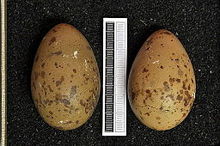Hawk sku
| Hawk sku | ||||||||||
|---|---|---|---|---|---|---|---|---|---|---|

Hawk sku ( Stercorarius longicaudus ) |
||||||||||
| Systematics | ||||||||||
|
||||||||||
| Scientific name | ||||||||||
| Stercorarius longicaudus | ||||||||||
| Vieillot , 1819 |
The hawk sku ( Stercorarius longicaudus ) is a species in the sku family . There are two subspecies. In Central Europe it is found less frequently than the Arctic Skua and the Spatula Skua . In Belgium, however, 432 individuals of this species were observed between 1991 and 1996 alone.
Appearance
The top of the head and the nape of the neck are shiny black. The chest and throat are white, the latter having a yellowish tinge. The back and the wing surface are colored brown-green. Furthermore, a distinctly long tail is noticeable. With a length of 40 to 55 centimeters and a weight of 220 to 350 grams, it is the smallest species of the skuas.
distribution
The hawk skua breeds in the arctic areas of Eurasia and North America . It is slightly more common in Alaska and northern Russia than in the rest of the Arctic. It breeds in the dry tundra and also seeks breeding grounds far from the coast. The European breeding population is estimated at 12,000 to 78,000 breeding pairs. The European part of Russia has the largest population with 10,000 to 50,000 breeding pairs. Between 1,000 and 20,000 breeding pairs breed in Greenland. Around 600 to 8,000 breeding pairs live in Fennoscandinavia.
Outside of the breeding season, the hawk sku is a distinct sea bird. The wintering areas are in the southern Atlantic and Pacific. In the North Atlantic it only winters exceptionally. The migration route to these wintering quarters has not been fully explored. Presumably the western Palearctic breeding birds migrate first to the North Atlantic and from there to the south at a greater distance from the coast. Migratory birds can be seen over the North Atlantic especially in late August and early September. Hawk skuas can be found off the coast of Namibia from the end of September. From the end of March they move back to their breeding areas, which they reach at the end of May at the earliest. Faithfulness to the breeding site has been proven for falcon skuas.
food
In the breeding areas, the typical seagull hunt for prey hardly plays a role in the falcon skua. Their food here consists mainly of bank voles , voles and similar small mammals. It also eats insects, eggs and smaller birds here. She also takes berries in smaller quantities as additional food. On the coast it mainly eats self-caught fish, crustaceans and cephalopods .
Inventory forecast
The hawk sku is considered to be one of the species that will be particularly hard hit by climate change. A research team that, on behalf of the British Environmental Protection Agency and the Royal Society for the Protection of Birds, examined the future distribution of European breeding birds on the basis of climate models assumes that the range of the falcon skua will shrink considerably by the end of the 21st century. Large parts of today's breeding area in Norway and Sweden will no longer offer suitable habitats for this species. Possible new distribution areas arise on Franz-Josef-Land and above all on Novaya Zemlya , but these potential gains in area cannot compensate for the loss of area.
supporting documents
literature
- Hans-Günther Bauer, Einhard Bezzel and Wolfgang Fiedler (eds.): The compendium of birds in Central Europe: Everything about biology, endangerment and protection. Volume 1: Nonpasseriformes - non-sparrow birds. Aula-Verlag Wiebelsheim, Wiesbaden 2005, ISBN 3-89104-647-2 .
Web links
- Stercorarius longicaudus onthe IUCN Red List of Threatened Species . Listed by: BirdLife International, 2008. Retrieved December 23, 2008.
- The migrations of the hawk skuas A project of the GREA (Groupe de recherches en écologie arctique), in which two falcon skuas equipped with mini satellite transmitters are observed on their migration.
- Feathers of the hawk sku
Single receipts
- ↑ Bauer et al., P. 553
- ↑ Bauer et al., P. 553
- ↑ Bauer et al., P. 553
- ↑ Bauer et al., P. 554
- ^ Brian Huntley, Rhys E. Green, Yvonne C. Collingham, Stephen G. Willis: A Climatic Atlas of European Breeding Birds , Durham University, The RSPB and Lynx Editions, Barcelona 2007, ISBN 978-84-96553-14-9 , P. 208

